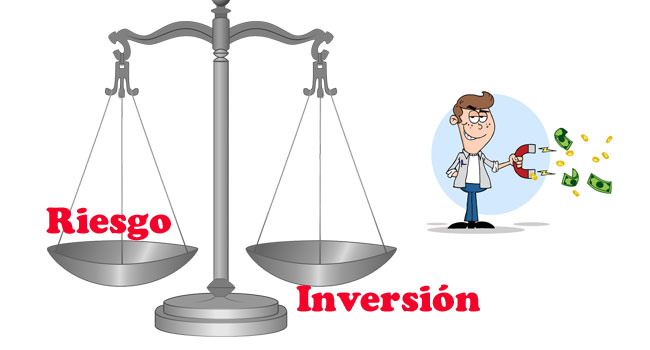Learn thanks to this article in detail about the risk measurement financial How is it done? and all its details.

Financial risk measurement
The financial risk measurement of an investment is directly subject to the currency in which it is invested, the market interest rate and finally the type of tool used.
There are two ways by which risk can be measured: Historical and Risk Ratings.
The first is related to the behavior of the type of investment instrument over time, how it has varied and what factors have affected it to behave the way it has. To materialize this, certain technical elements and expertise are required, in addition to having access to the historical records of said instrument.
However, it is possible to develop a basic analysis through an electronic spreadsheet and knowing the public reports of the company that issues said instrument, and identify the behavior it has had over time.
Considering the different peaks (highs and lows) and creating averages of these, but above all analyzing what caused them to be present in its history. If you want to know a little more about this extraordinary topic, I invite you to view this link Investment portfolio
Second, risk rating agencies are the source of information to measure the risk of an investment. These are in charge of carrying out the different analyzes and classification by risk levels.
These, to minimize their understanding strategy, classify the levels with the literals A, B, C, D and E; and with the symbols + and –; which determine the level of trust and credibility of each instrument, regarding the information generated by said companies based on:
- Solvency
- long-term debt
- short-term debt
- Obligations and insurance
Financial risk, or financial investment risk, is the risk of losing money. To calculate and determine them, we look at a concept; volatility is understood as the speed with which prices change and the magnitude of these changes.
The risks are related to the loss or decrease in the value of a financial asset, such as a loan or an investment. These are in turn classified into two different types:
- Market risk. Risk of loss is defined as price movements in the capital markets, whether in equity prices, raw materials, interest rates, exchange rates, credit spreads, etc.
- Liquidity risk, is generated when the purchase or sale of an asset, at the time of execution, requires a considerable reduction in price.
- Credit risk. It is the risk of incurring losses due to the fact that a counterparty does not respond to the payment obligations set forth in its contract.
- Another refers to the Exchange Risk: They are the changes or fluctuations, which determine the variation of the exchange rate in the currency.
- Interest rate risk: Volatility is translated as the difference between the active and passive rates of financial institutions.
- Market risk: It is the one that is linked to the stock market and its different instruments (stocks, bonds, etc.)
Financial risks are connected with losses in the value of a financial asset, such as a loan or an investment. The risk factors that affect an investment are not presented in isolation. To illustrate this consideration we will do an exercise which will be presented as follows:
- A bond is issued by the corporation. Through said issue, the entity will have to pay interest periodically to the bondholders and return the committed nominal N at the maturity of the issue. Investors who are interested in subscribing to this issue will pay an initial price P and will be subject to the following risks.
- Credit risk. This risk is contemplated in the event that the issuing entity fails to comply with the committed payments, whether interest or nominal. Since this bond is listed on the transactional market and is subject to the following market risks.
- Interest rate risk. It is the risk subjected to the variation of interest rates when they rise after the issue date, in this scenario the yield of the bond will be comparatively less attractive for the market, as a result of a fall in the price of the bond, with the consequent loss of value.
- Spread risk. It is the case in which the types of profit do not suffer differences and the issuer does not default on its payments, the situation of the issuing entity in its usual activity, may be harmed at the time of issuance.
The risk premium or spread of the investment will increase, decreasing the market value of the asset.
Return, risk and time. Each one of them represents a determining aspect within the investment strategy that you have. Of these three figures, risk defines most of the decision to capitalize on a specific project because the sustainability of the undertaking is in it.
5 Steps for the analysis of financial risk measurement
The analysis of the financial risk measurement is the probability that a threat will materialize and its possible impact.
Where should you start?
The financial risk measurement analysis of a company begins after having specified the possible risk events. Its objective is not only to estimate possible losses, but to prevent them from occurring.
In a credit risk analysis, it is the scenario where the possibility that a debtor cannot finish paying its obligations is evaluated.
For this reason, financial risk management must take into account the internal and external factors that could cause threats.
Internal factors are those that are generated by the very nature of the company's commercial activity. Poor cash management or production problems are risks that can affect the accounts and market value of a company.
On the other hand, external factors are subject to political, economic and social conditions, which affect the application of strategies and logistics for the development of the company, including crises, instability of exchange rates, variations in an industry or state policies.
The easiest method for applying the analysis of financial risk in a company, is to establish the probability that a risk will occur and the possible economic losses that may be caused.
Once the risks have been specified and after choosing the most convenient tool to control the events, the company can decide whether to avoid or assume the risks according to the company's level of tolerance or appetite for risk.
The following 5 steps manage financial risks:
Step 1: Identify Key Risks
For the financial risk analysis process, all the risk factors that your company faces are specified, and that may affect (costs, prices, inventory, etc.), government regulations, technological changes, changes in personnel, etc.
Step 2: Calculate the Weight of Each Risk
Prioritizing risks is essential to efficiently coordinate and direct resources and efforts. Thus, create a contingency plan, in case a threat materializes.
Step 3: Create a Contingency Plan
It is important to note that not all risks can be dealt with in the same way. In fact, some of them you may not be able to control or get out of hand. That is why it is prudent to specify the implementation of contingency plans, which are based on the level of tolerance and appetite for risk that the company has established.
Step 4: Assign Responsibilities
It is not possible to determine those responsible for each risk, one way to have some control is to designate a person in charge of monitoring critical events and their evolution over time. The most prudent thing is to diversify the responsibilities in adequate, responsible personnel and not centralize them in a single person.
Step 5: Set expiration dates
The monitoring and control strategies and plans cannot be executed indefinitely, since the threats would tend to multiply and would further disturb the processes. This determines the actions that must be taken, as these must be based on the time needed to carry out each task.
Value at Risk (VaR): What is it?
It is a statistical technique that allows to measure and establish the financial risk of an investment. It is in charge of specifying the probability, of considering a loss during a period of time.
It is defined as the probability of an event occurring and its resulting impacts or consequences.
There are three variables that affect each event and these are: the amount of the loss, the probability of loss and time.
The VaR measures the financial risk of an investment, this characteristic makes it recognized and has considerable application in the world of finance.
Companies can have an estimated projection of the benefits they will obtain for each investment compared to their VaR, and thus be able to invest more money, where there are more attractive scenarios and better returns for each unit of risk.
Value at Risk (VaR): Advantages
The different advantages offered by the VaR method are described below:
- It is easier to assess the risk, since all the risk of an investment is centralized in a single number.
- The risk measurement is under a single scheme, that is, standardized and, consequently, it can be easily compared, as it is widely calculated.
Value at Risk (VaR): Disadvantages
Below are detailed, the different disadvantages of the VaR methodology:
- The usefulness of this methodology is closely linked to the results that have been used to calculate it.
- Not all complex situations are considered in this methodology.
- Some of the methods to calculate it are highly expensive and difficult to apply.
- The measurement of financial risk es determinante, for any capitalization process. Since it considers the other elements (profitability and time) the reason that the probability that things do not turn out the way they were projected is based on them, and consequently, the option that they generate losses.
- In this sense, every investor must seize the available tools and take into account the financial risk of the investments, in order to then establish the strategies for the good performance of the capitalization.
Strategies to reduce financial risk measurement
Financial risk is the occurrence of circumstances that have negative consequences for the economy of a company or organization. This considers the possibility of both profits and losses being generated.
The types of financial risks
When possible circumstances that are detrimental to the business are detected, we can speak of different types of financial risks:
- Exchange: when it affects the volatility of the currencies with which you work.
- Interest rate: when its variations affect the finances of the business.
- Another is credit, when one of the parties does not comply with the obligations established in the contract.
- Liquidity: if any of the parties has financial assets, but cannot convert them into liquidity, to meet their obligations.
- Operational: If any human, technical or internal systems error is generated that causes financial losses.
Take the financial risk
When the financial risk is detected, the person in charge of the company can face it in three different ways: transferring it (through a sale or having it assumed by insurance), avoiding exposure to it and retaining it.
risk control
The challenge that an entrepreneur must assume is to reduce the possibility of the existence of a financial risk for his business. If within the probabilities it is impossible to eliminate the possibility of an event with negative consequences, there is a viable means to control its appearance; To achieve this, the following aspects must be taken into consideration:
- The income of an investment to be executed.
- Anticipation of possible problems, which can be done based on the data collected on the elements related to the investment.
- The transformation into different types of investments, which can help the danger of some with others with more guarantees. This includes the system hedging, an economic way in which assets from the same portfolio are combined, so that the safest ones compensate for the most variable ones.
- Finally, it is necessary to evaluate the partial results that are obtained during a financial operation, since this information will help to anticipate possible problems in the future.







